Sudbury is a small, ancient market town in the county of Suffolk, England, on the River Stour, 15 miles (24 km) from Colchester and 60 miles (97 km) from London.
Sudbury’s history dates back into the age of the Saxons. The town’s earliest mention is in 799 AD, when Aelfhun, Bishop of Dunwich, died in the town. The Saxon Chronicle records the town as Suthberie (“south-borough”), presumed to distinguish it from Norwich or Bury St Edmunds, to the North. The town is also mentioned in the Domesday Book of 1086, as a market town where the local people came to barter their goods. The market was established in 1009.
A community of Dominicans arrived in the mid-13th century and gradually extended the size of their Priory, which was one of three Dominican priories in the county of Suffolk. Sudbury was one of the first towns in which Edward III settled the Flemings, allowing the weaving and silk industries to prosper for centuries during the Late Middle Ages. As the main town in the area, Sudbury prospered too, and many great houses and churches were built, giving the town a major historical legacy. The Woolsack in the House of Lords was originally stuffed with wool from the Sudbury area, a sign of both the importance of the wool industry and of the wealth of the donors.
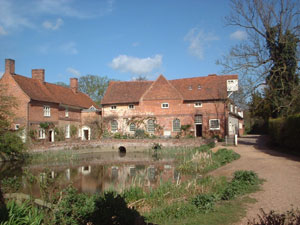
Flatford Mill is on the River Stour close to the Suffolk-Essex border. The Centre buildings, particularly the Mill and Willy Lott’s House, are instantly recognisable since they feature in many paintings by John Constable. Only an hour from London and with excellent road and rail access, the Centre is at the end of a lane which has no through traffic. It offers visitors of all ages a much sought-after sense of tranquility to complement a unique learning environment.The rich mosaic of lowland landscapes, wildlife habitats and places of historic interest in this beautiful part of East Anglia are all reflected in the Centre’s wide-ranging programme of environment and art-based courses. Over 300 residential and day activities are offered each year for people of all ages.
More information can be found at: http://www.field-studies-council.org/flatfordmill/
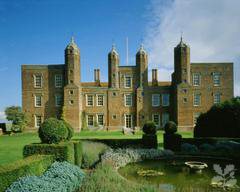
This fine Tudor building is the home of the Hyde Parker family, lords of the manor of Melford, though the house itself is now owned by the National Trust. The manor once belonged to the Abbots of Bury St Edmunds, but after the Dissolution of the Monasteries it passed to Sir William Cordell, a lawyer who later rose to become speaker of the House of Commons.
The estate of Melford Hall is entered through a fanciful Victorian gateway, but the exterior of the house itself is pure Tudor, built for Cordell in the period 1554-1578. The house is built of red brick, with three wings partly enclosing a courtyard. The interior, however, shows signs of later remodeling; particularly by Thomas Hopper (1813-1820).
Hopper was responsible for the staircase with classical columns, and the double library, with its fittings of oak inlaid with walnut and yew. Much of the furnishings , including numerous family portraits, relate to the Hyde Parkers, who came to the manor in 1786. Pride of place, however, must go to a map of the estate, dated to 1580.
The banqueting hall is largely unchanged from the days when Elizabeth I was feted here. The library dates largely from the Regency period, and the bedrooms were remodeled in the Victorian era.
Melford Hall contains a good collection of articles associated with author Beatrix Potter, who was related to the Hyde Parker family. Visitors can see a shawled model of Jemima Puddleduck in addition to several of Potter’s sketches and watercolour illustrations for her children’s stories.
The gardens at Melford Hall are worth a visit; there are some fine varieties of old trees, a banqueting house, and some enjoyable walls through the parkland surrounding the house.
More information can be found at: http://www.nationaltrust.org.uk/main/w-melfordhall
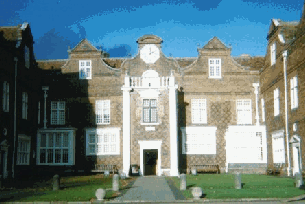
The house is surrounded by Christchurch Park, a grand landscaped park featuring many beautiful trees (235 of which were destroyed in the gale force storms of October 1987), rolling lawns and duck pond. The park is around 70 acres (280,000 m2) in size. The mansion itself houses a collection of pottery and glass, a contemporary art gallery and a collection of paintings by artists including John Constable and Thomas Gainsborough. There are rooms preserved as past inhabitants would have known them, complete with original items of fine clothing. The mansion is a Grade I listed building.
Christchurch Park was originally a monastic ground, with an area of many square miles. During Henry VIIIs dissolution of the monasteries, the monastery was razed to the ground and the land was purchased by Sir Edmund Withipoll, who built the original mansion. His granddaughter Elizabeth Withipoll married Leicester Devereux, 6th Viscount Hereford and the mansion passed to the Devereux family. In 1734, Claude Fonnereau purchased the mansion from Price Devereux, 10th Viscount Hereford. A road next to the park is named after the family.
The next owner of the mansion was Felix Cobbold in 1892, after plans were made public about the demolition of the mansion and using the parkland for housing construction. Cobbold opposed these plans, and said to the Corporation of Ipswich that if he purchased the mansion, and they bought the surrounding parkland it would be donated to the people of Ipswich. It took Cobbold three attempts to get the corporation to agree to this, but in February 1895 the mansion was transferred to the town and in April 1895 the corporation purchased the rest of the estate. Felix Cobbold, among other members of his wealthy family have donated a great deal of land to the people of Ipswich, including Ipswich Racecourse.
More information can be found at: http://www.britainexpress.com/counties/suffolk/Christchurch_Mansion.htm
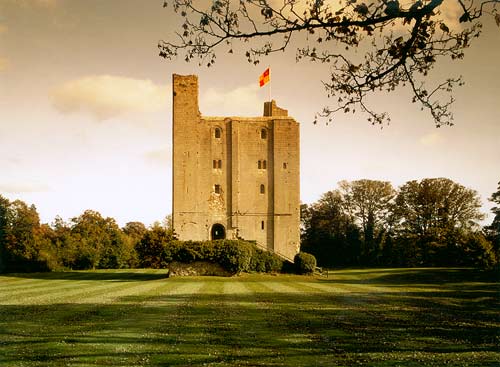
Hedingham Castle‘s Norman keep, 110 feet high, was built c.1140 by Aubrey de Vere and is still owned by one of his descendants, The Honourable Thomas Lindsay and his wife Virginia. There are four floors to explore, including a magnificent Banqueting Hall spanned by a remarkable 28 foot arch, one of the largest Norman arches in England. A good view of this splendid room can be obtained from the Minstrels’ Gallery, built within the thickness of the 12 foot walls. A visit to the castle and its beautiful grounds is ideal for a family outing, and during the summer there are a variety of special events which bring its colourful history alive. Come and enjoy one of our exciting Jousting Tournaments or other entertainments.
Castle weddings in medieval surroundings. For those wishing to get married in a Castle, it is now possible to have a romantic candlelit Civil Ceremony in the Banqueting Hall.
Small receptions can be held in the elegant rooms of the Georgian house which is a beautiful location for Wedding Receptions and is also perfect for delightful, intimate Winter Weddings. For larger parties or those requiring dancing, there is a marquee on the private Tulip Lawn. Drinks can be served on the terrace which has beautiful views over the lake.
More information can be found at: http://www.hedinghamcastle.co.uk/
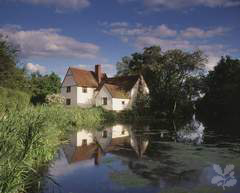
Come and spend the day in Flatford, home of the beautiful 16th-century thatched Bridge Cottage, which is located in the heart of Dedham Vale?
This is the location for John Constable’s famous idyllic pastoral paintings, and visitors are invited to attend exhibitions held in the cottage.
One of the best ways to experience the countryside that John Constable knew and loved is to take the Constable Country Walk around the picturesque Stour Valley. By following in the footsteps of Constable you’ll have a better appreciation of the trees, rivers, sounds and light captured on canvass by one of the greatest British painters of all time.
More information can be found at: http://www.suffolktouristguide.com/East_Bergholt/
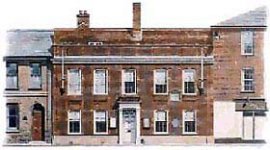
Gainsborough’s House is a typical example of Suffolk vernacular architecture, constructed from a timber frame with wattle and daub infill. The building was originally two cottages that were joined together in about 1520. A brick facade was added in the 1720s by the artist’s father. In the 1790s additions were made to the back of the house to make it a more elegant residence.
In the 1890s the property was purchased by a builder and parts of it were sold off. The warehouse, used for storing cloth, was sold and part of the extensive garden was developed as a silk factory.
Gainsborough’s House, the only artist’s birthplace open to the public in Britain, was established as a museum in 1961. It shows a large collection of Gainsborough’s paintings, drawings and prints as well as temporary exhibitions. The £9 million project to transform Gainsborough’s House museum in Sudbury will see will see the renovation of the historic house as well as the construction of a new three-storey landmark building. The National Lottery Heritage Fund funded the project with around £5.2m, with the rest being matched by private donations. This will create the largest gallery in Suffolk, providing spaces for exhibitions, displays and learning with four new galleries – including a landscape studio with panoramic views over Sudbury.
More information can be found at: http://www.gainsborough.org/
